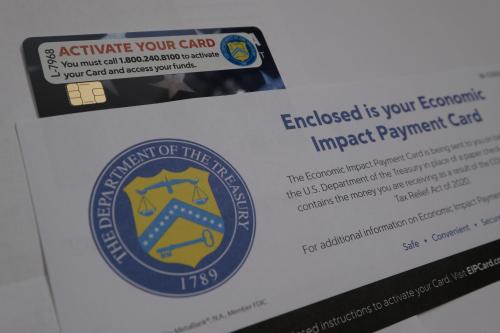In addition to large fiscal packages, governments around the world utilized credit market interventions to support their economies during the pandemic. However, the impact and importance of these policies has not been fully analyzed. Gee Hee Hong of the IMF and Deborah Lucas of MIT approach this problem in their new BPEA paper, and they discuss their findings on this episode of the Brookings Podcast on Economic Activity with Wendy Edelberg of The Hamilton Project.
- Listen to the Brookings Podcast on Economic Activity on Apple, Spotify, Google, or wherever you like to get podcasts.
- Learn about other Brookings podcasts from the Brookings Podcast Network.
- Sign up for the podcasts newsletter for occasional updates on featured episodes and new shows.
- Send feedback email to [email protected].
TRANSCRIPT
[music]
STOCK: I’m Jim Stock, coeditor of the Brookings Papers on Economic Activity, the semiannual academic conference and journal that pairs rigorous research with real time policy analysis to address the most urgent economic challenges of the day. On behalf of my coeditor Jan Eberly of Northwestern University, as well as the rest of the Brookings team, I’d like to thank you for joining us for this episode of the Brookings Podcast on Economic Activity. Here we share conversations with leading economists on the research they do and how it will affect economic policy.
On this episode, you’ll hear from Deborah Lucas of MIT and Gee Hee Hong of the International Monetary Fund and their new paper, “COVID credit policies around the world: Size, scope, costs and consequences.” They’ll be interviewed by Wendy Edelberg of the Hamilton Project.
Governments have long used credit policies to complement standard fiscal policies. Credit policies include things like subsidizing or guaranteeing loans and loan forbearance. The United States in particular, made significant use of credit policies during the COVID pandemic, for example, through the Paycheck Protection Program. Looking forward as fiscal capacity gets stretched in many countries, it’s plausible that governments will increasingly look towards credit policies as tools for achieving broader policy goals.
The expansion of credit policies raises many questions, starting with how large they are and how effective they are. This is a vast research program, and Lucas and Hong take an important first step by examining credit policies during the COVID pandemic. They have quite a few interesting findings, and I hope you enjoy this episode. I’ll now hand it over to Wendy, Deborah and Gee Hee.
EDELBERG: Thank you, Jim. I am Wendy Edelberg, director of the Hamilton Project at Brookings. And joining me today is Gee Hee Hong, an economist at the Fiscal Affairs Department at the International Monetary Fund, and Debbie Lucas, the Sloan Distinguished Professor of Finance at the MIT Sloan School of Management and director of the MIT Golub Center for Finance and Policy. We’ll be discussing their new paper, which they presented at the Spring 2023 Brookings Paper on Economic Activity Conference in Washington, D.C. So first, let me say thank you, Gee Hee and Debbie, for joining me today.
So, Gee Hee, let’s start with you. You guys both analyzed the size and effect of many types of credit policies used by countries during the height of the pandemic. Can you describe for our listeners some of those policies?
HONG: Sure. First of all, Wendy, thank you very much for having us. So, if we go back to what happened in 2020, in the face of an unprecedented public health crisis, governments imposed lockdown measures to limit economic activity which actually jeopardized people’s livelihoods and the survival of businesses.
So, to support households and firms, governments introduced a flurry of measures. And in this paper, we are focusing on credit policies such as credit guarantee programs, governments direct lending to households and firms, as well as large scale loan forbearance and payment moratoria programs, which actually allowed borrowers to stop making payments on mortgages, rents, and student loans, for instance.
And this was a crucial pillar of government support during COVID. Countries made available more than $6 trillion at the global level. But despite this sheer size, we noticed that credit policies are often underappreciated in the literature and more importantly, in the narrative when we talk about the economic impact of macro policies introduced during COVID. So, this is, in our view, one important contribution of our paper to recognize the important role credit policies played during the pandemic and perhaps in the years that follow.
EDELBERG: Yeah. I think your paper is going to be an amazing resource in that regard. Debbie, let’s bring you in. So, your paper talks about the challenges of sizing these policies. Can you walk us through why that’s more complicated than that just looking at the dollars appropriated by policymakers or looking at total amounts of loans or something like that?
LUCAS: Thanks, Wendy, for asking about that. In fact, an important message of our paper is that official government statistics all too often entirely fail to measure or mismeasure the size and cost of these credit policies. In fact, the lack of reliable and readily available official statistics we think is an important reason, maybe the most important reason, that economists typically haven’t tried to quantify the effects of credit policies on a macroeconomic scale. To quote an old saw, what isn’t measured isn’t seen. So, an important part of what we do in this paper and in some of our other recent work is to produce statistics on the size and cost of the credit programs that are suitable for macroeconomic analysis.
I also want to emphasize that there’s not a one size fits all statistic for these programs. Certainly one aspect is the size of their budgetary cost or equivalently the associated government subsidies that are conveyed to borrowers.
A second aspect and the one we focus on most in this paper is related to how much funding that households and firms obtain through these programs. So, just to contrast the two, in most instances the cost or the subsidy is much smaller than the funding obtained because much of the borrowing is going to be eventually repaid.
But you asked specifically about why appropriations aren’t an adequate measure. I guess the simplest answer is that the authorized size of these programs in the U.S. and elsewhere significantly exceeds the amounts of funds they provided. That’s what we call “take up.”
You also astutely mentioned the total amount of loans made is irrelevant. In fact, that’s what we’re striving to measure for loan guarantees and direct lending programs. The idea is that those amounts are at least as a first approximation similar in their stimulus effects to that of traditional fiscal policy.
But unfortunately, those statistics are just not commonly reported, at least not centrally reported. We found data on take up from a variety of sources, including reports by the agencies administering the programs. We found the situation to be even more complicated for the large scale forbearance programs. Many of those arose outside of the normal appropriation process, and there’s typically extremely little information that’s made publicly available. So, measuring the amount of additional funds obtained with forbearance is more complicated and also requires some assumptions and some financial math to take into account that it’s the missed payments not the take up that’s the relevant concept for measuring the potential stimulus arising from those programs.
EDELBERG: So, the title of your paper includes “size, scope, costs, and consequences,” that you set a difficult task for yourself. Tell me about the findings that you want the listeners to know?
LUCAS: Well, we found that these credit policies, when they’re properly measured, significantly increase the resources in the pockets of firms and households. It brought the average share of funds obtained from 14 and a half percent of GDP when you only look at fiscal policies, to 22% when all of these credit and forbearance policies are added on top of traditional fiscal measures.
What was maybe the most striking to us and something we certainly weren’t expecting is the very different picture one gets of the relative aggressiveness of government policies across these countries. So, whereas there’s considerable variation in the use of traditional fiscal policies—and notably the U.S. looks particularly aggressive by that measure—if you look at the cross-country variation, it’s much lower when credit and forbearance policies are also taken into account.
Now, in terms of the macroeconomic effects of these policies, we also find some interesting results. Although I must say that the sample size is just seven countries and this one episode, so we can’t draw any formal inferences.
But with that disclaimer, a finding that was quite suggestive of the importance of credit support and forbearance policies is that there’s a much stronger positive correlation between the cross section of real GDP growth in late 2020 through late 2021 when you look at the broad measure that includes credit programs then if you just look at fiscal spending alone.
We also find that the very elevated savings rates during 2020 and 2021 are highly correlated with the combined funds provided by credit and fiscal policies.
We also wanted to explore the connection between credit policy and inflation. We don’t find that including credit policies helps to directly explain the cross section of inflation across these countries. But we’d conjecture that the much higher and more uniform levels of incremental resources provided by European and U.S. governments and the likelihood that a significant fraction of all of these resources were initially saved rather than spent is at least consistent with pandemic fiscal and credit policies having significantly contributed to the sharp increase in subsequent inflation in all of these countries.
EDELBERG: Debbie, one more question for you. So, you talked about the importance of take up in in your measurements. So, one factor I know that was important in the U.S. just from other work that I’ve done was that some sectors of the economy bounced back very quickly and the size of fiscal support going to households meant tremendous support for spending. So, how do you think about the relationship between credit policies in 2020 and in 2021 and other fiscal policies? I guess what I’m trying to get at is if businesses saw enormous demand for their products because of the fiscal support going to households that helped to support spending, how do you think about the interplay between those kinds of fiscal support for households and take up for these loans by businesses and the like?
LUCAS: Yeah, that’s a great question. I just want to actually first note that in responding to the pandemic, the U.S. actually relied much less heavily on credit support than did all of the other countries we studied. In fact, the U.S. primarily depended on the fiscal policies that you just mentioned.
However, what the U.S. did was for the first time they introduced these large scale forbearance programs, particularly for government backed mortgages and for student loans. And, you know, those forbearance policies we estimated represented a pretty modest fraction of GDP, about six-tenths of 1%. Those programs also helped people that were struggling to meet those fixed expenses, much as expanded unemployment insurance or the checks sent to households did. So, I would say that those forbearance policies complemented some of the fiscal stimulus that was provided.
Interesting in the U.S. context is that it was possible to authorize those policies without any congressional action because they affected existing government loan programs where there was already administrative authority to provide forbearance. So, that’s something special to the U.S., which lets them get money out the door quite quickly by introducing forbearance policies.
EDELBERG: Gee Hee, I have a question for you about take up and whether or not take up may underestimate how important credit programs are. So, some have argued that even for credit programs that had little take up—and here, just for context, what I’m thinking about is like some of the Fed programs, credit programs in the U.S. that had very little take up—some have argued that even though those programs may have had very little take up, their existence was hugely important for confidence, just for example. So, does that sound right? And then how should we how should we then think about that channel of credit programs mattering in the context of all of your findings?
HONG: That’s a great question, Wendy. To be clear, I think there is an element in any policy announcements that will affect sentiment. And as you mentioned, the Fed credit program, or the central bank liquidity facilities, of government providing a backstop when uncertainty is high, they will certainly boost confidence in the market. But for credit policies, we think that households and firms may be more interested in perhaps in actually using these policies because they will directly alleviate their debt burdens or relax their credit constraints, for instance.
So, in that context, the aspect that interested us more was the design of policy. For instance, how terms of guarantees and forbearance were designed and how they made programs attractive so that economic agents would actually use them.
EDELBERG: So, let me throw this question wide open to both of you and thinking that our listeners are probably maybe even more focused on the financial system right now than at other times, what are your findings telling you about policy going forward? Like, should credit policies be used alongside conventional monetary policy and fiscal policy? Like, how important is this in policymakers’ toolkits?
HONG: So, in our paper, our findings suggest that these credit policies can be a very powerful tool to support households and businesses, potentially at a much lower cost than other traditional fiscal measures. But these needs to be very carefully designed and well targeted.
And in our view, going forward credit policies are likely to play a more prominent role because if you think about countries facing limited fiscal space with high levels of debt and spending to rise further to tackle various, for instance, short-term and long-term challenges like climate agenda, credit policies are going to be a very attractive option for governments to continue to support the economy without overburdening the budget.
So, this means that the credit policy will continue to play a more important role, but also at the same time, there should be a caution that they should pay more attention and recognize that the budget cost of the fiscal risks related to the programs.
LUCAS: Thanks, Gee Hee. I’d agree with a lot of what you said, but my bottom line is that credit policy should be used only with extreme caution. You mentioned that credit support programs can be effective, but I would say that’s really only clearly true during episodes where there’s a breakdown in the functioning of private credit markets or also as a way to help target beneficiaries like students and small businesses with limited access on their own to credit markets and that wouldn’t be able to obtain credit without government support.
But I think that all too often these policies are used in preference to more transparent forms of assistance. Not only do they hide the upfront costs of providing credit, but they leave governments exposed to considerable future financial risk. That risk is, for instance, that guarantees will be called upon when the economy is very weak, when fiscal resources are already very strained.
And so, I also think that now that these credit policies have become more normalized by their aggressive rollout during the pandemic, it’s likely they, in fact, will be adopted more readily in future crises. So, to prepare for that, I think governments need to revamp their disclosures about credit policies and make their costs and risks much more transparent. And I’m hoping that the economics profession will help them in getting there.
EDELBERG: So, Debbie and Gee Hee, you both talked about the use of credit programs, both during times of crisis, but also during times when markets are just not complete and households or businesses don’t have access to credit, which may be occurring, obviously, outside of times of crisis. So, Debbie, you’ve alluded to this, but can I draw you out a little bit more to draw the distinction between when credit programs should be used simply in a time of crisis or when credit programs might be appropriate, just as a more structural part of fiscal policy.
LUCAS: Yeah. Thanks, Wendy. So, I personally believe that these programs should only be used to correct market imperfections. And the reason for that is because of their lack of transparency. And, the fact that they’re mostly outside of the budget process makes them very undisciplined. But when they have economic justification is when they’re addressing some kind of an externality or serious problem in the markets.
So, there’s episodic problems, like during the global financial crisis where credit markets just stopped functioning. And there was also that concern that it might happen during COVID. So, during a large crisis, there’s a reason for governments to step in and support credit markets to make sure that they continue to function.
But other than a severe crisis, as you mentioned, the reason to have credit programs is to correct kind of standing market imperfections that arise because of what you might refer to as incomplete information. So, young borrowers with no credit history, students, or small businesses have limited access to credit. I guess another example is people who want to buy houses who don’t have a lot of credit history might be unable to do so in the completely unregulated private market. So, there is a rationale for governments to come in and support credit for those purposes in a kind of on a kind of standing basis.
EDELBERG: This has been a super conversation. And let me just reiterate something I said earlier, which is your paper is going to be just a tremendous resource going forward as we think about not just what role credit programs played during the height of the COVID-19 pandemic, but also how we should be using these programs going forward and be thinking about them and measuring them and thinking about their effectiveness.
So, I just want to thank you both for putting in this incredibly hard work to write this paper.
[music]
LUCAS: Thank you so much, Wendy, for the opportunity to talk about this with you and to get the message out.
HONG: Thank you, Wendy.
STOCK: Once again, I’m Jim Stock, Harold Hitchings Burbank Professor of Political Economy at Harvard and coeditor of Brookings Papers on Economic Activity with Jan Eberly of Northwestern University, and this has been the Brookings Podcast on Economic Activity. Thanks to our colleagues for this great conversation and be sure to subscribe to hear more discussions with BPEA authors.
The Brookings Podcast on Economic Activity is produced by the Brookings Podcast Network. Learn more about this and our other podcasts at Brookings dot edu slash podcasts. Send feedback to podcasts at Brookings dot edu, and find out more about the Brookings Papers on Economic Activity on the website, Brookings dot edu slash BPEA.
Thanks to the team that makes this podcast possible, including Kuwilileni Hauwanga, supervising producer; Fred Dews, producer; and Gastón Reboredo, audio engineer; with support from Shannon Meraw and Chris Miller in Economic Studies at Brookings. Show art was designed by Katie Merris of Brookings, and promotional support comes from our colleagues in Brookings Communications and Economic Studies.
The Brookings Institution is committed to quality, independence, and impact.
We are supported by a diverse array of funders. In line with our values and policies, each Brookings publication represents the sole views of its author(s).











Commentary
PodcastHow did credit market interventions affect macroeconomies during COVID-19?
April 13, 2023
Listen on
Brookings Podcast on Economic Activity